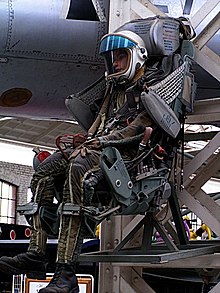KM-1
The KM-1 is a Soviet ejection seat that was developed by OKB Mikoyan-Gurewitsch under the project name SK-3 ( Russian Система катапультирования , "Sistema katapultirowania "). KM-1 stands for Кресло Микояна (Kreslo Mikojana), "Mikojan's seat". From 1965 it was used in series with the MiG-21 (from version PF), the MiG-23 as well as with the MiG-25 and MiG-27 .
All processes of the ejection seat work automatically. After the rescue process has been triggered, the cabin roof is blown off. At the same time, a belt tensioner is triggered and the arm guards are activated. Then the ejector cylinder is activated and a process computer started, which initiates the further measures autonomously. After about 2.5 cm of travel, all connections to the aircraft are disconnected. After about 10 cm the first stabilization screen is triggered. After 40 cm, the legs are pulled to the seat and the rocket motor is ignited after 80 cm.
At speeds below 280 KIAS , the first stabilization parachute is immediately ejected and the second stabilization parachute is ejected. The arm guards fold back and the seat separates from the pilot when the altitude is less than 3050 m. At higher speeds and altitudes, the process is delayed accordingly.
The KM-1 has an emergency oxygen system and a survival kit in the seat shell.
The KM-1M version has better arm protection. The successor to the KM-1 was the K-36 in the 1980s .
Others
In August 1981, the Soviet test pilot Alexander Konovalov catapulted himself out of a MiG-25R with an ejector seat KM-1M at about Mach 2.6 at a height of 18,000 m and survived.
Operating limits
- Minimum speed on the ground: 70 KIAS
- Maximum speed on the ground: 275 KIAS
- Minimum height from 275 to 635 KIAS: 31 m
- Minimum height from 635 to 665 KIAS: 915 m
- Minimum height in descent: 55 m
Individual evidence
- ↑ Jan Kokuschkin / Lasar Egenburg: Ejection seats for the MiGs. In: Flieger Revue 7/1993. P. 16
